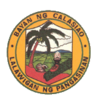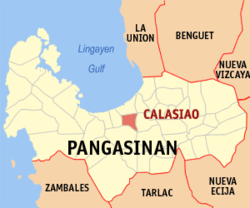- Calasiao, Pangasinan
-
Calasiao — Municipality — 
SealMap of Pangasinan showing the location of Calasiao. Location in the Philippines Coordinates: 16°01′N 120°22′E / 16.017°N 120.367°ECoordinates: 16°01′N 120°22′E / 16.017°N 120.367°E Country  Philippines
PhilippinesRegion Ilocos Region (Region I) Province Pangasinan District 3rd District, Pangasinan Founded Barangays 24 Government – Mayor Mark Roy Macanlalay Area – Total 48.36 km2 (18.7 sq mi) Population (2007) – Total 85,419 – Density 1,766.3/km2 (4,574.7/sq mi) Time zone PST (UTC+8) ZIP code 2418 Income class 1st class; urban Population Census of Calasiao Census Pop. Rate 1995 69,528 — 2000 77,039 2.23% 2007 85,419 1.43% Calasiao is a 1st class municipality in the province of Pangasinan, Philippines. According to the latest census, it has a population of 85,419 people with 15,020 households. In the Pangasinan language, the town is called "Baley na Calasiao" which means "town of Calasiao" in English. The name Calasiao was derived from the native word "Kalasian", which means a place where lightnings frequently occur. The word Kalasian comes from the root word "lasi" which means lightning. Upon the arrival of the Spaniards, they called the place, "Lugar de Rayos" which is a literal translation of the word Kalasian.
Contents
Government
The town hall is located in front of the Roman Catholic convent of San Pedro y San Pablo de Calasiao, and it is at the same building as the shrine of Senor Divino Tesoro. The current mayor is Mayor Roy T. Macanlalay. One of his major projects is to add a roof above school basketball courts or school yards in every barangay school in Calasiao. He has won thrice of the mayoral election and currently serving final term until 2010. His son, Mark Roy Macanlalay, will take over as the new mayor on July 2010 following his victory in the May elections. Also the High council secretary of barangay Dinalaoan united is Corneilio Terrado Marquez.
Language
The people speak the Pangasinan language which is called Pangalatok which only the town of Calasio uses, the dominant language in Central Pangasinan. Ilokano, Tagalog, and English are also widely spoken.
History
The indigenous people of Calasiao are descended from the Austronesian-speaking people who settled in the Malay archipelago at least 5,000 years ago. Calasiao was settled by a Pangasinan speaking people whose language belongs to the Malayo-Polynesian branch of the Austronesian languages family.
In 1571, the Spanish conquest of Pangasinan began. The Spanish conquistadors were accompanied by Roman Catholic missionaries who introduced Roman Catholicism to the indigenous peoples of Pangasinan. Around 1592, the small settlement of Calasiao was united with the other neighboring small settlements of Nalsian and Dinalaoan to form the new town of Calasiao. The much larger settlement of Gabon and other settlements also became part of the new town of Calasiao. The town of Calasiao became part of the Pangasinan encomendia of Labaya, designated as belonging to the King of Spain, Juan Ximenez del Pino, and a son of Alonso Hernandez de Sandoval for whom tributes were collected.
Augustinian and Dominican missionaries converted most of the indigenous people of Calasiao to Roman Catholicism. In 1596, the Roman Catholic convent in Calasiao was built and named San Pablo de Calasiao. In 1621, the convent was renamed San Pedro y San Pablo de Calasiao. The convent is located in the town center or poblacion.
Today, Calasiao is a progressive town. Calasiao may soon become a city or join with Dagupan City and San Carlos City to be a metropolis.
Many people from Calasiao have emigrated to the United States and other countries to seek better opportunities.
Attractions
Calasiao is centrally located in Pangasinan, between Dagupan City and San Carlos City. A major highway connects Calasiao to Dagupan City, San Carlos City, San Carlos City, and Urdaneta City, which then connects to Baguio City and Metropolitan Manila. Calasiao is only a few minutes ride to the Bonuan Blue Beach and the Hundred Islands on the Lingayen Gulf. Calasiao is about an hour ride to Baguio City and a four hour ride to Manila.
Calasiao is known for its puto, a soft rice cake; suman, a sweet coconut and sticky rice cake wrapped in banana leaves; and bagoong, or fermented fish paste. Calasiao puto is described as the town's "white gold."[citation needed] Calasiao puto is a bite-size, soft rice cake made from semi-glutinous rice that is fermented in earthen jars. It is produced mainly in Barangay Dinalaoan.
Many pilgrims from neighbouring cities/towns and provinces visit Calasiao to pray at the Senor Divino Tesoro shrine. The statue of a crucified Jesus Christ is believed to grow in size and grant miracles.
Industries
Calasiao has rich farmlands planted mainly with palay or rice, coconuts and mangoes. Calasiao also has a lot of fishponds along its rivers and wetlands where fish like bangus or milkfish, pantat or catfish, and tilapia are raised. A Coca-Cola Bottlers plant is located in Calasiao. The plant is famed for producing one of the best tasting Coca-Cola in the world.[citation needed]
Because of Calasiao's great business potential, fast-food chains Jollibee, Chowking and Gery's Grill opened a branch in the town, while huge car companies such as Toyota, Honda, Nissan and Mitsubishi have opened a dealership in the town. The Regency Hotel in Calasiao has become the biggest competitor of the Star Plaza Hotel in Dagupan City. Dagupeńa, a famous world-class restaurant in Dagupan City has also moved to Calasiao.
In June 2010, Robinsons Land Corporation (RLC) announced it will be putting up its 30th mall in this progressive town. Robinsons Place Calasiao will be a two-level mall built on a 5.8-hectare lot with a gross floor area of 31,900 square meters and a gross leasable area of 23,000 sqm.
Free puto festival
Calasiao (pop: 85,419)[citation needed] will celebrate on May 5, 2008, its (free) puto industry festival. It is known for its 100 years "white gold: "cup-shaped, bite-sized, soft rice cakes; the semi-glutinous rice is fermented in old earthen jars" (in villages of Dinalaoan, Lumbang, Ambuetel, and part of Nalsian).[1] The Calasiao Puto is a rice cake that is well known all over the Philippines for its melt-in-the-mouth feeling. It is locally sold along the streets going to Sr. Divino Tesoro.[citation needed]
Bocayo (sweetened coconut) and Dinuguan are also the best products of Nalsian Bacayao and Nalsian Centro. Calasiao celebrates its town fiesta every May 2 & 3, the feast day of Señor Divino Tesoro. Every 28th & 29 June is the fiesta of San Pedro and San Pablo, which was then the dates of the Calasiao fiesta.
Barangays
Calasiao is politically subdivided into 24 barangays. Calasiao enjoys its success due to the central location and proximity to Dagupan City. Businesses have more potential for success since the town is traversed by the national highway (MacArthur)
- Ambonao
- Ambuetel
- Banaoang
- Bued
- Buenlag
- Cabilocaan
- Dinalaoan
- Doyong
- Gabon
- Lasip
- Longos
- Lumbang
- Macabito
- Malabago
- Mancup
- Nagsaing
- Nalsian
- Poblacion East
- Poblacion West
- Quesban
- San Miguel
- San Vicente
- Songkoy
- Talibaew
External links
- Municipality of Calasiao Official Website
- Philippine Standard Geographic Code
- 2007 Philippine Census Information
- Calasiao Homepage
References
Dagupan City • Binmaley • Calasiao • Lingayen • Manaoag • Mangaldan • Mapandan • San Fabian • San Jacinto • Santa BarbaraMunicipalities - Agno
- Aguilar
- Alcala
- Anda
- Asingan
- Balungao
- Bani
- Basista
- Bautista
- Bayambang
- Binalonan
- Binmaley
- Bolinao
- Bugallon
- Burgos
- Calasiao
- Dasol
- Infanta
- Labrador
- Laoac
- Lingayen
- Mabini
- Malasiqui
- Manaoag
- Mangaldan
- Mangatarem
- Mapandan
- Natividad
- Pozorrubio
- Rosales
- San Fabian
- San Jacinto
- San Manuel
- San Nicolas
- San Quintin
- Santa Barbara
- Santa Maria
- Santo Tomas
- Sison
- Sual
- Tayug
- Umingan
- Urbiztondo
- Villasis
Component cities - Alaminos
- San Carlos
- Urdaneta
Independent component city (Administratively independent from the province, but grouped under Pangasinan by the National Statistics Office)
Dagupan Mangaldan Manaoag
Mapandan
Lingayen, Binmaley 
Santa Barbara, Urdaneta  Calasiao
Calasiao 

San Carlos City Malasiqui Categories:- Municipalities of Pangasinan
Wikimedia Foundation. 2010.


